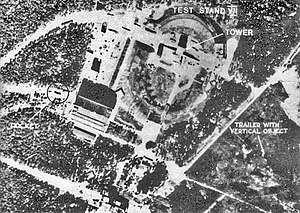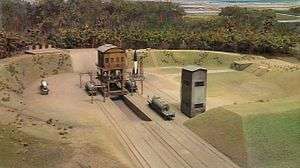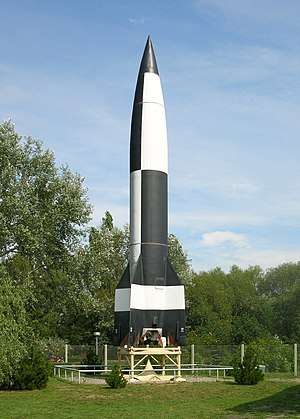Peenemünde Army Research Center
The Peenemünde Army Research Centre (German: Heeresversuchsanstalt Peenemünde,‡ HVP) was founded in 1937 as one of five military proving grounds under the German Army Weapons Office (Heereswaffenamt).[1]:85 Several German guided missiles and rockets of World War II were developed by the HVP, including the V-2 rocket. The works were attacked by the British in Operation Crossbow from August 1943, before falling to the Soviets in May 1945.
| Peenemünde Army Research Centre | |
|---|---|
| Peenemünde, Germany | |
 1943 RAF photo-recon of Test Stand VII at the Peenemünde Army Research Centre | |
| Coordinates | 54.143°N 13.794°E |
| Site history | |
| Built | 1937 |
| In use | World War II |
| Battles/wars | Operation Crossbow (Bombing of Peenemünde in World War II) |
History
On April 2, 1936, the aviation ministry paid 750,000 reichsmarks to the town of Wolgast[1]:41 for the whole Northern peninsula of the Baltic island of Usedom.[2]:17 By the middle of 1938, the Army facility had been separated from the Luftwaffe facility and was nearly complete, with personnel moved from Kummersdorf.[3] The Army Research Center (Peenemünde Ost)[4] consisted of Werk Ost and Werk Süd, while Werk West (Peenemünde West) was the Luftwaffe Test Site (Erprobungsstelle der Luftwaffe),[5]:55 one of the four test and research facilities of the Luftwaffe, with its headquarters facility at Erprobungsstelle Rechlin.
HVP organization
Wernher von Braun was the HVP technical director (Dr. Walter Thiel was deputy director) and there were nine major departments:[4]:38
- Technical Design Office (Walter J H "Papa" Riedel)
- Aeroballistics and Mathematics Laboratory (Dr. Hermann Steuding)
- Wind Tunnel (Dr. Rudolph Hermann)
- Materials Laboratory (Dr. Mäder)
- Flight, Guidance, and Telemetering Devices (German: BSM) (Dr. Ernst Steinhoff)[6]
- Development and Fabrication Laboratory (Arthur Rudolph)
- Test Laboratory (Klaus Riedel)
- Future Projects Office (Ludwig Roth)[7]
- Purchasing Office (Mr. Genthe)
The Measurements Group (Gerhard Reisig) was part of the BSM,[8] and additional departments included the Production Planning Directorate (Detmar Stahlknecht),[5]:161 the Personnel Office (Richard Sundermeyer), and the Drawings Change Service.[9]
Guided missile and rocket development

Several German guided missiles and rockets of World War II were developed by the HVP, including the V-2 rocket (A-4) (see test launches), and the Wasserfall (35 Peenemünde trial firings),[10] Schmetterling, Rheintochter, Taifun, and Enzian missiles. The HVP also performed preliminary design work on very-long-range missiles for use against the United States. That project was sometimes called "V-3" and its existence is well documented. The Peenemünde establishment also developed other technologies such as the first closed-circuit television system in the world, installed at Test Stand VII to track the launching rockets.
According to Walter Dornberger, "Rockets worked under water." In the summer of 1942, led by Ernst Steinhoff, Pennemünde worked on sea launches, either from launching racks on the deck of a submerged submarine, or from towed floats. Dornberger summarized the launches from a depth of 30 to 50 feet, "A staggering sight it was when those twenty heavy powder rockets suddenly rose, with a rush and a roar, from the calm waters of the Baltic."[11]
Aerodynamic Institute
The supersonic wind tunnel at Peenemünde's "Aerodynamic Institute" eventually had nozzles for speeds up to the record speed of Mach 4.4 (in 1942 or 1943), as well as an innovative desiccant system to reduce the condensation clouding caused by the use of liquid oxygen, in 1940. Led by Rudolph Hermann, who arrived in April 1937 from the University of Aachen, the number of technical staff members reached two hundred in 1943, and it also included Hermann Kurzweg of the (University of Leipzig) and Walter Haeussermann.[12]
Heimat-Artillerie-Park 11
Initially set up under the HVP as a rocket training battery (Number 444),[13] Heimat-Artillerie-Park 11 Karlshagen/Pomerania[13]:125 (HAP 11) also contained the A-A Research Command North[13]:65 for the testing of anti-aircraft rockets. The chemist Magnus von Braun, the youngest brother of Wernher von Braun, was employed in the attempted development at Peenemünde of anti-aircraft rockets.[13]:66 These were never very successful as weapons during World War II. Their development as practical weapons took another decade of development in the United States and in the U.S.S.R.
Peenemünde V-2 production plant
In November 1938, Walther von Brauchitsch ordered construction of an A-4 production plant at Peenemünde, and in January 1939, Walter Dornberger created a subsection of Wa Pruf 11 for planning the Peenemünde Production Plant project, headed by G. Schubert, a senior Army civil servant.[14] By midsummer 1943, the first trial runs of the assembly-line in the Production Works at Werke Süd were made, [15] but after the end of July 1943 when the enormous hangar Fertigungshalle 1 (F-1, Mass Production Plant No. 1) was just about to go into operation, Operation Hydra bombed Peenemünde. On August 26, 1943, Albert Speer called a meeting with Hans Kammler, Dornberger, Gerhard Degenkolb, and Karl Otto Saur to negotiate the move of A-4 main production to an underground factory in the Harz mountains.[2]:123[5]:202 In early September, Peenemünde machinery and personnel for production (including Alban Sawatzki, Arthur Rudolph, and about ten engineers)[4]:79 were moved to the Mittelwerk, which also received machinery and personnel from the two other planned A-4 assembly sites.[16] On October 13, 1943, the Peenemünde prisoners from the small F-1 concentration camp[17] boarded rail cars bound for Kohnstein mountain.[16]
Operation Crossbow
Two Polish janitors[18]:52 of Peenemünde's Camp Trassenheide in early 1943[18]:52 provided maps,[19] sketches and reports to Polish Home Army Intelligence, and in June 1943 British intelligence had received two such reports which identified the "rocket assembly hall", "experimental pit", and "launching tower".[2]:139 The Allies also received information about the V-2 rockets and the production sites from the Austrian resistance group around the priest Heinrich Maier.[20][21]


As the opening attack of the British Operation Crossbow, the Operation Hydra air-raid attacked the HVP's "Sleeping & Living Quarters" (to specifically target scientists), then the "Factory Workshops", and finally the "Experimental Station"[22] on the night of August 17/18, 1943.[23] The Polish janitors were given advance warning of the attack, but the workers could not leave due to SS security and the facility had no air raid shelters for the prisoners.[18]:82
A year later on July 18,[24] August 4,[6]:111 and August 25,[2]:273 the U.S. Eighth Air Force[4]:141 conducted three additional Peenemünde raids to counter suspected hydrogen peroxide production.[25]
Evacuation
As with the move of the V-2 Production Works to the Mittelwerk, the complete withdrawal of the development of guided missiles was approved by the Army and SS in October 1943.[26] On August 26, 1943, at a meeting in Albert Speer's office, Hans Kammler suggested moving the A-4 Development Works to a proposed underground site in Austria.[27] After a site survey in September by Papa Riedel and Schubert, Kammler chose the code name Zement (cement) for it in December,[26] and work to blast a cavern into a cliff in Ebensee near Lake Traunsee commenced in January 1944.[13]:109 To build the tunnels, a concentration camp (a sub unit of Mauthausen-Gusen) was erected in the vicinity of the planned production sites. In early 1944, construction work started for the test stands and launching pads in the Austrian Alps (code name Salamander), with target areas planned for the Tatra Mountains, the Arlberg range, and the area of the Ortler mountain.[28] Other evacuation locations included:
- Hans Lindenmayr's valve laboratory near Friedland moved to a castle near the village of Leutenberg, 10 km (6 mi) south of Saalfeld near the Bavarian border.[4]:293
- the materials testing laboratory moved to an air base at Anklam
- the wind tunnels moved to Kochel (then after the war, to the White Oak, Maryland-located U. S. Navy's Naval Ordnance Laboratory)[29]
- Engine testing and calibration to Lehesten[30]
- Thuringia
For people being relocated from Peenemünde, the new organization was to be designated Entwicklungsgemeinschaft Mittelbau (English: Mittelbau Development Company)[4]:291 and Kammler's order to relocate to Thuringia arrived by teleprinter on January 31, 1945.[4]:288 On February 3, 1945, at the last meeting at Peenemünde held regarding the relocation, the HVP consisted of A-4 development/ modification (1940 people), A-4b development (27), Wasserfall and Taifun development (1455), support and administration (760).[4]:289 The first train departed on February 17 with 525 people en route to Thuringia (including Bleicherode, Sangerhausen (district), and Bad Sachsa) and the evacuation was complete in mid-March.[1]:247
- Occupied Poland
Another reaction to the aerial bombing was the creation of a back-up research test range near Blizna, in southeastern Poland. Carefully camouflaged, this secret facility was built by 2000 prisoners from the Pustkow concentration camp.[31] The Polish resistance movement (Armia Krajowa) succeeded in capturing an intact V2 rocket here in 1943. It had been launched but didn't explode and was later retrieved intact from the Bug River and transferred secretly to London.[32]
Post-war
The last V-2 launch at Peenemünde happened in February 1945, and on May 5, 1945, the soldiers of the Soviet 2nd Belorussian Front under General Konstantin Rokossovsky captured the seaport of Swinemünde and all of Usedom Island. Soviet infantrymen under the command of Major Anatole Vavilov stormed the installations at Peenemünde and found "75 percent wreckage". All of the research buildings and rocket test stands had been demolished.[33]
Although rumors spread that the Soviet space program revived Peenemünde as a test range,[34] more destruction of the technical facilities of Peenemünde took place between 1948 and 1961. Only the power station, the airport, and the railroad link to Zinnowitz remained functional. The gas plant for the production of liquid oxygen still lies in ruins at the entrance to Peenemünde. Very little remains of most of the other Nazi German facilities there.
The Peenemünde Historical Technical Museum opened in 1992 in the shelter control room and the area of the former power station and is an anchor point of ERIH, the European Route of Industrial Heritage.
In popular culture
- Peenemünde is a setting in the novels Fatherland, Gravity's Rainbow, Moonraker, The Rhinemann Exchange, The Way the Crow Flies, and Space.
- In the novels of the Colonization series, and in some other novels, Peenemünde survived World War II and later became a major space exploration launch center.
- The 1965 British thriller Operation Crossbow is a highly fictionalized account of the Nazi development of the V-1 and V-2 and the Anglo-American campaign to interdict it.
- The Nazi occupation of Poland and the Allied bombing of Peenemünde are depicted in the British feature film Battle of the V-1 (1958) (called Missiles From Hell in the United States and some other countries), which starred the actor Michael Rennie.
- In the second book of the Danger Boy series of time travel tales, written by Mark London Williams, Dragon Sword, Peenemünde becomes a key setting in this and in the further novels.
- In the movie The Cockpit, Peenemünde becomes a test site for atomic bombs.
- In the television series, UFO Hunters, Episode 305, "Nazi UFOs",[35] the hunters visit Peenemünde to track down evidence and interview experts about a rumored Nazi space exploration program that took place there.
See also
- Aggregate (rocket family)
- Mikhail Devyatayev
References
^‡ A different spelling is Heeresversuchsstelle Peenemünde,[4]:36 and Heeresanstalt Peenemünde appears on a German document with Wasserfall velocity calculations.[13]:78
- Dornberger, Walter (1954) [1952]. V2- Der Schuss ins Weltall: Geschichte einer grossen Erfindung [V2-The Shot into Space: History of a great invention]. Esslingen: Bechtle Verlag. pp. 41, 85, 247.
- Irving, David (1964). The Mare's Nest. London: William Kimber and Co. pp. 17, 139, 273.
- WGBH Educational Foundation. NOVA: Hitler's Secret Weapon (The V-2 Rocket at Peenemünde) motion picture documentary, released in 1988 by VESTRON Video as VHS video 5273, ISBN 0-8051-0631-6 (minutes 20:00-22:00)
- Ordway, Frederick I., III.; Sharpe, Mitchell R. The Rocket Team. Apogee Books Space Series 36. pp. 36, 38, 79, 117, 141, 285, 288, 289, 291, 293.
- Neufeld, Michael J. (1995). The Rocket and the Reich: Peenemünde and the Coming of the Ballistic Missile Era. New York: The Free Press. pp. 55, 88, 161, 202, 204–6, 222, 247.
- Huzel, Dieter K. (1960). Peenemünde to Canaveral. Prentice Hall. p. 37.
- "Dahm, Werner Karl". Peenemünde Interviews. National Air and Space Museum. Archived from the original on 2003-10-17. Retrieved 2008-10-23.
- McCleskey, C.; D. Christensen. "Dr. Kurt H. Debus: Launching a Vision" (PDF). Archived from the original (pdf) on 2008-09-17. Retrieved 2008-10-23.
- Huzel. 149,225
- Pocock, Rowland F. (1967). German Guided Missiles of the Second World War. New York: Arco Publishing Company, Inc. p. 107.
- Dornberger, Walter (1954). V-2. New York: The Viking Press, Inc. p. 214-216.
- Neufeld. 88
- Klee, Ernst; Merk, Otto (1965) [1963]. The Birth of the Missile:The Secrets of Peenemünde. Hamburg: Gerhard Stalling Verlag. pp. 44, 65, 66, 78, 109, 117, 125.
- Neufeld. 119,114
- Middlebrook, Martin (1982). The Peenemünde Raid: The Night of 17–18 August 1943. New York: Bobs-Merrill. p. 23.
- Neufeld. 206
- Neufeld. 222
- Garliński, Józef (1978). Hitler's Last Weapons: The Underground War against the V1 and V2. New York: Times Books. pp. 52, 82.
- "Poland's Contribution in the Field of Intelligence to the Victory in the Second World War". Retrieved 2008-11-09.
- Peter Broucek "Die österreichische Identität im Widerstand 1938–1945" (2008), p 163.
- Hansjakob Stehle "Die Spione aus dem Pfarrhaus (German: The spy from the rectory)" In: Die Zeit, 5 January 1996.
- "Peenemünde - 1943". Weapons of Mass Destruction (WMD). GlobalSecurity.org. Retrieved 2006-11-15.
- Warsitz, Lutz: THE FIRST JET PILOT - The Story of German Test Pilot Erich Warsitz (p. 63), Pen and Sword Books Ltd., England, 2009
- Neufeld. 247
- Irving. 273,309
- Neufeld. 205
- Neufeld. 204
- Irving. 123,238,300; Klee & Merk. 109
- Hunt, Linda (1991). Secret Agenda: The United States Government, Nazi Scientists, and Project Paperclip, 1945 to 1990. New York: St.Martin's Press. p. 31. ISBN 0-312-05510-2.
- Reuter, Claus. The V2 and the German, Russian and American Rocket Program. May 2000. S.R. Research & Publishing. 978-1894643054. pages 114-115; 137
- Rockets and People, Boris Chertok
- Jewishgen.org: Pustkow Concentration Camp (Poland) . retrieve 5.15.2013
- Ley, Willy (1958) [1944]. Rockets, Missiles and Space Travel. New York: The Viking Press. p. 243.
- Ley, Willy (October 1959). "For Your Information". Galaxy. p. 73. Retrieved 14 June 2014.
- Nazi UFOs. [Internet]. 2012. The History Channel website. Available from: http://www.history.com/shows/ufo-hunters/episodes/episode-guide [Accessed 1 Mar 2012].
External links
| Wikimedia Commons has media related to Peenemünde Army Research Center. |